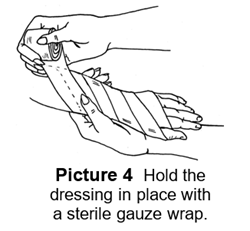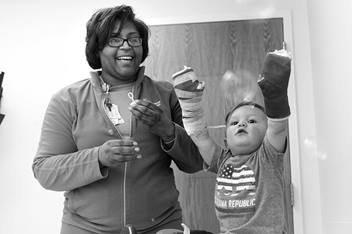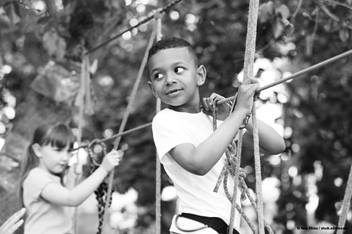Dressing Change: Burns
![]()
Your child has been treated for a burn. The dressing (bandage) needs to be changed every day. This will help the burn heal faster and prevent infection.
There are several types of dressings for burns. The nursing staff will teach you how to care for your child’s burn. The doctor has ordered the following:
Change dressing and apply (name of medicine) _________________________________ to unhealed burns _____ times a day.
Supplies
You will need the following items. Your child's nurse will give you some to start with.
- Sterile gauze pads
- Sterile gauze roll (Kerlix®)
- Non-sterile gauze squares or clean washcloths
- Sterile, non-adherent (non-sticking) or petroleum-based dressing
- Tongue depressors or clean table knife (if using ointment)
- Mild soap without perfume or artificial coloring
- Clean basin or pan
- Medicine, as ordered by the doctor
- Medical tape (silk tape)
- Paper or plastic bag
How to Change the Dressing
If needed, give pain medicine 30 minutes before starting. Your child can take acetaminophen (Tylenol®) or ibuprofen (Motrin®, Advil®).
- Read the label to know the right dose for your child.

- Do not give ibuprofen to children younger than 6 months (Picture 1).
- Do not give aspirin or products that contain aspirin.
Explain to your child the steps you will do to change the dressing. Use simple words that they can understand.
- Wash your hands (Picture 2).

-
Set up all supplies in a clean area within easy reach.
- Place a bag nearby so that you can throw away all dirty dressings and used supplies at each step.
- Fill the basin or pan with warm water.
- Remove the old dressing.
- If it sticks to the burn, you may loosen it first with a few drops of water. Drip warm water onto the bandage and let sit for a few seconds.
- Look at the old dressing for signs of infection. Has the drainage changed color or does it have a foul smell?
- Wash your hands again (Picture 2).
- Wash the burned area with mild soap and water. Use a clean washcloth or gauze squares. Gently wipe the area to remove all drainage and crusting. Do not worry if some bleeding occurs. This is normal.
- If you used a washcloth, do not use it again before washing.
- Your child may take a bath or shower in cool to lukewarm water. If taking a bath, make sure the tub is clean.
- Rinse the burned area with clean, lukewarm water.

- Pat the area dry with a clean towel, washcloth, or gauze squares.
- Look closely at the burned areas to check the healing.
- Cover all open burn areas with non-adherent burn dressing. Touch only the edges of it when putting it on the skin. Then, cover the area with dry sterile gauze (Picture 3). Do not put dry gauze directly on burned areas that have not healed.
- Hold the dressing in place by wrapping a sterile gauze roll over the dressings (Picture 4). Start wrapping the limb from the place farthest away from the body. Secure the wrap with tape. Do not wrap or tape the wrap too tightly because this can reduce blood flow to the limb.
Ointment Dressings
Sometimes, pre-packaged non-adherent dressings will need ointment put on them. Follow steps 1 through 8 above. After step 8, use a tongue depressor or clean table knife to spread a thin layer of ointment onto the dressing.
- Do not spread the ointment directly on the burn.
- Do not put your fingers into the ointment jar or apply the ointment to the gauze pads with your fingers.
Continue with steps 9 and 10 above.
After the Dressing Change
- Wash your hands one more time.
- Put all unused supplies away in a clean, dry place.
- Store medicines in a safe place where your child cannot reach.
- If used, clean the basin, pan, bathtub, or shower.
- Throw away the bag with dirty gauze and used supplies where no one can get to them.
Nutrition
It is important for your child to eat healthy foods and to
drink plenty of fluids (Picture 5). Skin tissue needs lots
of calories to heal. A nutritious diet also helps to prevent infection. Your child should:
- Eat foods high in protein such as meat, eggs, yogurt, cheese, beans, and peanut butter.
- Limit snack foods and candy.
- Limit soda, high sugar drinks, and fruit juices. Drink milk or milk substitutes and water instead.
Care After the Burn Has Healed
It can take a few weeks to several months for a burn to heal. The skin may be red, dry, scaly, and itchy for a while. Even after you no longer have to do dressing changes, the healed skin needs to be protected. Burned skin is more prone to injury than normal skin.
The following tips may help to reduce itching and prevent re-injuring the healed skin. Your child should:
- Not scratch dry itchy skin.
- Apply non-perfumed skin lotion over the healed burn at least 3 to 5 times a day to relieve dry skin or itching. You may use lotions that contain cocoa butter, aloe or lanolin. You do not need to buy the most expensive brand.
- Keep your child's fingernails trimmed short. Clean socks placed over the hands like gloves may reduce nighttime scratching.
- Wear clothes that will not rub against or irritate the skin.

- Wear loose clothes.
- Change out of wet clothes as soon as possible.
- Clothes worn next to the skin should be washed and rinsed well. Any detergent left in the clothes can irritate the skin.
- Avoid overheating.
- Wear only enough clothing to be comfortable. If your child gets too warm, healed areas may start to itch.
- Stay out of direct sun.
- Avoid being outside between 10 AM and 2 PM, when the sun’s rays are strongest.
- Wear hats with a big brim, sunglasses, and other sun-protective clothing (Picture 7).
- Use a sunscreen lotion with a sun protection factor (SPF) of at least 30.
- Apply at least 30 minutes before going outside. Reapply every 2 hours and after water exposure, such as swimming or sweating.
- Use outdoors on both sunny and cloudy days.
When to Call the Doctor
Call the doctor if you notice one or more of the following signs.
- Changes in the color, amount, or odor of the drainage
- Swelling or redness around the burn
- Increased pain at the site
- Your child is not eating and drinking
- A lot of bleeding when the dressing is changed
- Changes in how a leg or arm looks - cool or hot to touch, swelling, or color change
- Fever over 102°F (38.9°C) that lasts more than 2 days
- For infants 4 months of age or older, take rectal, ear, or axillary (armpit) temperature.
- When your child reaches 4 years of age, taking oral (mouth) temperature is OK.
HH-II-106 10/11, Revised 10/19 | Copyright 2011, Nationwide Children’s Hospital



